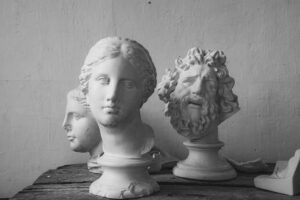Art is a beautiful and diverse expression of human creativity that has the power to inspire, provoke, and delight. However, for many of us, understanding art can be an intimidating task- What should we look for? How do we interpret it? And most importantly, how do we appreciate it? If you’re a beginner looking to develop your understanding and appreciation of art, then this blog post is just what you need! From decoding common artistic terms to exploring different styles and movements in art history, this guide will equip you with all the knowledge you need to start appreciating art like a pro. So let’s dive in!
What is art?
It seems like a simple question, but “what is art?” can actually be quite difficult to answer. Is it a painting? A sculpture? A photograph? A song? A play? Art can be any of these things and more.
Some people might say that art is anything that is beautiful, or that expresses an emotion. Others might say that art is something that is created with the intention of being aesthetically pleasing. And still others might say that art is something that provokes thought or creates conversation.
There is no single correct answer to the question “what is art?” because art means different things to different people. However, there are some general characteristics that are often used to describe art: originality, creativity, emotion, beauty, and meaning.
Originality: Artistic works are typically original creations of the artist, rather than copies of other works.
Creativity: Artistic works are often creative or imaginative, making use of unusual or unexpected elements.
Emotion: Artistic works can evoke strong emotions in viewers, such as happiness, sadness, anger, or fear.
Beauty: Many people believe that art should be beautiful or aesthetically pleasing.
Meaning: Artistic works often have deep meanings or symbolism attached to them, which can be interpreted in different ways by different people.
Elements of art
In order to appreciate art, it is important to understand the elements of art. The elements of art are line, shape, form, color, value, space, and texture.
Line is the basic element of drawing. It can be used to create different shapes and forms. Line can be horizontal, vertical, or diagonal.
Shape is created when a line encloses an area. Shapes can be geometric or organic. Geometric shapes are regular and have specific names, such as circles, squares, and triangles. Organic shapes are irregular and do not have specific names.
Form is a three-dimensional object. A form has height, width, and depth. Examples of form include spheres, cubes, and cylinders.
Color is created when light reflects off of an object’s surface. Color has three properties: hue (the name of the color), value (how light or dark the color is), and intensity (how bright or dull the color is).
Value is the darkness or lightness of a color. Value is created by adding white or black to a color. A high value contrast means there is a large difference between the darkest and lightest values in an image. A low value contrast means there is a small difference between the darkest and lightest values in an image.
Space is the area around, above, and below an object. There are two types of space: positive and negative. Positive space is the focus of an image
Types of art
There are many different types of art, from paintings and sculptures to photography and architecture. But what all art has in common is that it is a expression of human creativity.
One of the most popular types of art is painting. Paintings can be either abstract or realistic. Abstract paintings are usually characterized by their use of color and shape to create a certain mood or feeling. Realistic paintings, on the other hand, aim to depict the world as accurately as possible.
Sculpture is another popular type of art. Sculptures can be made from a variety of materials, including stone, metal, glass, and wood. They can be either representational (meaning they depict something from real life) or abstract (meaning they don’t depict anything in particular).
Another type of art that has gained popularity in recent years is photography. Like painting, photography can be either representational or abstract. But unlike painting, which is static, photography captures a moment in time that can never be reproduced exactly again. This makes each photograph unique and special.
And finally, there is architecture. Architecture is perhaps the most functional form of art – after all, buildings have to serve a purpose! But that doesn’t mean that architects can’t also create beautiful and inspiring structures. In fact, some of the most famous landmarks in the world are architectural masterpieces.
Why appreciate art?

Why appreciate art?
In short, art appreciation is the ability to see the value in a work of art. It is about understanding how an artist has used their skills to create something that has meaning and purpose. When you appreciate art, you are valuing it for more than just its appearance.
Art appreciation can be a difficult concept to grasp, especially if you have never been exposed to much art before. However, it is something that can be learned with a little bit of time and effort. Here are a few tips on how to start appreciating art:
1. Take your time when looking at a work of art. Don’t just glance at it and move on. Instead, really look at it and try to understand what the artist was trying to achieve.
2. Ask questions about the artwork. If you’re not sure about something, ask a gallery attendant or do some research online. The more you know about a piece, the easier it will be to appreciate it.
3. Try to view artwork from different genres and periods. Don’t just stick to what you like or what you’re familiar with. Expanding your horizons will help you develop a broader understanding of art as a whole.
4. Be open-minded when looking at artwork. Approach each piece with an open mind and give it a chance before passing judgement on it. You may be surprised by what you end up liking!
How to appreciate art
In order to appreciate art, one must be willing to look at it with an open mind and heart. It is also important to have some knowledge about the different styles and periods of art. However, it is not necessary to be an expert in order to enjoy and appreciate art.
Here are some tips on how to appreciate art:
1. Take the time to look at the artwork carefully. Don’t just glance at it; really take a good, long look.
2. Study the composition of the piece. Notice the shapes, colors, and lines used by the artist.
3. Ask yourself what you like or don’t like about the piece. What emotions does it evoke in you?
4. Try to find out more about the artist and his or her background and motivations. What was he or she trying to communicate through this work of art?
5. Compare the artwork to other pieces by the same artist or from the same period or genre. How does it compare in terms of style, subject matter, technique, etc.?
6. Most importantly, relax and enjoy looking at the artwork!
Conclusion
Appreciating art is not a talent that you are born with, but it is something that can be learned. With dedication and an open mind, anyone can learn to appreciate art in all its forms and understand the stories being told by the artist. Our beginner’s guide has provided you with some tips on understanding what kind of story each piece of art tells so that you can develop your own personal appreciation for art as a form of expression and communication. So take some time out of your day to explore different artwork from around the world and let yourself get lost in its beauty.








